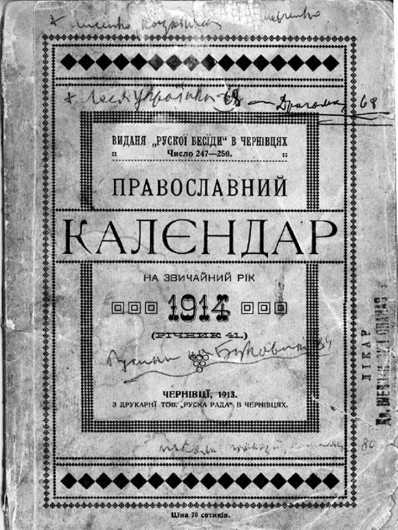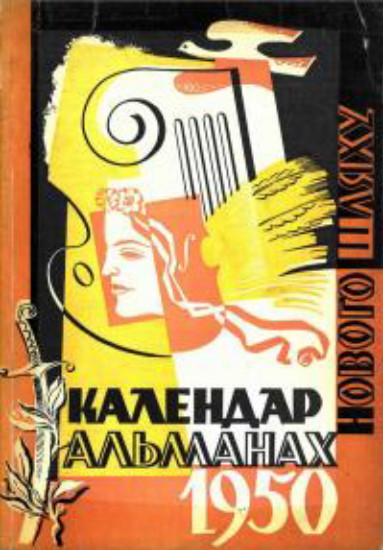Calendar (kalendar)
Calendar (kalendar) [календар]. Scholarly and literary almanac that has been popular since the 17th century, particularly in Western Ukraine. It developed from a supplement to liturgical books called misiatseslov (menology), which, besides a daily calendar, contained various information.
In 1525 Frantsisk Skoryna published a well-known calendar entitled Malaia podorozhnaia knizhitsia (The Little Travel Book) in Vilnius. It contained a psalter, prayer book, acathistus, canon, hexaemeron, calendar, and Easter calendar. After the Act of Union (see Church Union of Berestia) had been signed in 1595, Ipatii Potii and Kyrylo Terletsky published in Rome Kalendar ryms’kyi novyi (The New Roman Calendar) for the Uniates.
In the 17th and 18th centuries the calendars of Ormiński, S. and F. Niewieski, and particularly of S. Duńczewski (Kalendarz polski i ruski [Polish and Ruthenian Calendar], 1725–75), published in Polish in Lviv and Zamość, were popular. The most popular calendar in all of Ukraine was the so-called Kolindar entitled Kalendarz gospodarski (The Farmer's Calendar), which was published in Polish and Russian in the period 1760 or 1780 to 1864. At first it was printed in Berdychiv and, after the closing of the printery there, in Kyiv and Zhytomyr. It was reprinted in various Ukrainian cities, including Kharkiv (1797, 1799, 1808, 1809).
In the 18th century the printers of the Kyivan Cave Monastery Press published calendars. The first of them came out in 1700 under the title Kalendar’ ili mesiatseslov (Calendar or Menology). At the end of the century two calendars were published periodically in Kyiv: a church calendar and Astronomo-politicheskii kalendar' (The Astronomical-Political Calendar).
In the 19th century the Kyivan Cave Monastery Press published a well-known calendar, beginning in 1845: Polnyi khristiianskii mesiatsoslov s prisovokupleniem raznykh statei k rossiiskoi istorii i Kievskoi eparkhii otnosiashchikhsia (The Complete Christian Menology Supplemented with Various Articles on Russian History and the Kyiv Eparchy). Besides church news it contained a list of Ukrainian princes, Russian rulers, and Kyiv bishops (see Kyiv eparchy); articles on the monasteries and churches of the Kyiv metropoly; and other information. From 1864 to 1915 Kievskii narodnyi kalendar’ (The Kyiv Folk Calendar) was published in Kyiv. The 1867 issue contains L. Kvas's engravings.
In Western Ukraine, Polish and German calendars—Pielgrzym Lwowski (The Lviv Pilgrim, 1822) and Der Pilger vom Lemberg (1823), which were composed by the professors of Lviv University with the participation of the historian Denys Zubrytsky—provided the Ukrainian reader with interesting information.
The earliest Ukrainian calendars, such as Misiatsoslov (Menology) in Lviv, Peremyshlianyn (Peremyshl Resident) in Peremyshl, and Pozdravlenie rusynov (Ruthenian Greetings) in Transcarpathia, did not come out periodically. Peremyshlianyn (1850–61, 1863, 1864), under Rev Antin Dobriansky's editorship, rivaled the best foreign calendars with its rich contents. L'vovianyn, pryruchenyi i hospodars’kyi misiatsoslov (The Lviv Resident, A Handy Domestic Menology, 1861–2, 1882–4), composed by V. and Ya. Velychko, also deserves to be mentioned. In 1862 the first women's calendar appeared—Peremyshlianka (Woman of Peremyshl). Furkalo (Spinning Top, 1869), published in Kolomyia, was the first satirical calendar.
The Stauropegion Institute in Lviv published the first periodic calendar—Vremennik Stavropigiiskogo instituta s mesiatsoslovom (The Periodical of the Stauropegion Institute with a Menology, 1864–1915 and 1923–39). This calendar appeared annually and contained a wealth of scholarly articles. From 1870 to 1939 the Prosvita society in Lviv published a calendar, whose initial title was Kalendar narodnyi (The Folk Calendar). The Transcarpathian calendar Misiatsoslov was published in Uzhhorod in 1867 by the Society of Saint Basil the Great. The Ruska Besida in Bukovyna published Misiatsoslov bukovynsko-russkyi (The Bukovynian-Ruthenian Menology) in 1873 in Chernivtsi.
In the 1920s–1930s various Ukrainian organizations in Western Ukraine published calendars. Some of them are important sources of historical materials on the various movements in Galicia: the Prosvita society's calendar on culture and education; the calendars Zaporozhets’ (The Zaporozhian Cossack, 1904–14), Chervona kalyna (The Red Guelder Rose, 1921–39), and Dnipro (1923–39) on politics; Sil’s’kyi hospodar (The Village Farmer), Kalendartsi kooperatora (The Co-operative Organizer's Calendars), and Zolotyi kolos (The Golden Ear of Corn) on economy and co-operatives; Misionar (The Missionary, 1921–39) on education; and Zhinocha dolia (Woman's Fate, 1925–39) on the women's movement. The calendars reached regions of Ukraine that, because of political obstacles, were closed to Ukrainian books; for example, in the Kholm region and Podlachia M. Vavrysevych's calendars were read, and in Polisia and Podlachia Pravoslavnyi kalendar (The Orthodox Calendar) was read.
In central and eastern Ukraine the most popular calendars were Oleksa Hattsuk's Russian Krestnyi kalendar' (Calendar of the Cross, 1866), K. Andriiashev's calendar, and the address calendars published by gubernial governments or zemstvos. Among the Ukrainian calendars the calendar of the Kyiv Prosvita society (1907, 1908) and odryvni kalendari (wall calendars) of the Chas publishing house were widely known. In 1919 the first Soviet calendar appeared; it is still published today under the title Kalendar-dovidnyk (Reference Calendar) by Politvydav Ukrainy publishers in Kyiv. This calendar does not mark the days with the names of saints but with historical events of the USSR and the birth and death dates of Soviet political and cultural figures. Propagandistic material on economics and culture was included in Kalendar znamennykh i pam’iatnykh dat (Calendar of Significant and Memorable Dates, published from 1957). Provincial calendars did not differ from those of the capital.
During the First World War calendars were published for Ukrainian émigrés and soldiers in Vienna, prisoners of war at Wetzlar and Freistadt, and refugees at Gmünd. The Ukrainians in the Bačka region published Ruski kalendar za iugoslavianskikh rusinokh (A Ruthenian Calendar for Yugoslavian Ruthenians) from 1920. Ukrainian calendars were published by émigrés in Warsaw and Cracow (Kalendar-al’manakh Ukraïns’koho vydavnytstva [Calendar-Almanac of Ukrainske Vydavnytstvo Publishers]), Prague (Nastup [Advance]), and Berlin. Today calendars are published by various civic and church organizations in the countries to which Ukrainians have emigrated. These calendars contain historical material and information about cultural life and political developments in Ukraine and the émigré communities. For the history of Ukrainian life in the United States the calendars of such organizations as the Ukrainian National Association (published since 1897), the Ukrainian Fraternal Association (since 1911), and the Providence Association of Ukrainian Catholics in America (since 1918) are very valuable. In Canada the calendars of the newspapers Ukraïns’kyi holos (since 1915) and Kanadiis’kyi farmer (since 1920) are the most important. In Brazil the calendar of Pratsia (Brazil) (Work), published since 1921, and in Argentina the calendars of the Prosvita society and Vidrodzhennia society are rich sources of historical data.
BIBLIOGRAPHY
Shchurat, V. ‘Deshcho pro kalendar,’ Kalendar Nedilia (Lviv 1930)
B.R. ‘Iak postaly kalendari,’ Kalendar Krynytsia (Lviv 1936)
‘Kalendar—knyha znannia,’ Kalendar dlia vsikh (Lviv 1936)
Shelesnivkov, S. Istoriia kalendaria i khronologiia (Moscow 1977)
Sofiia Yaniv
[This article originally appeared in the Encyclopedia of Ukraine, vol. 1 (1984).]

